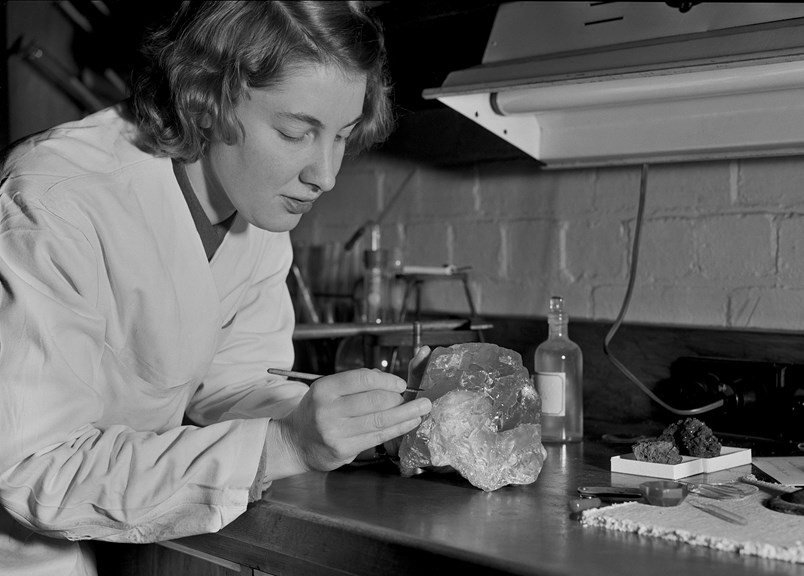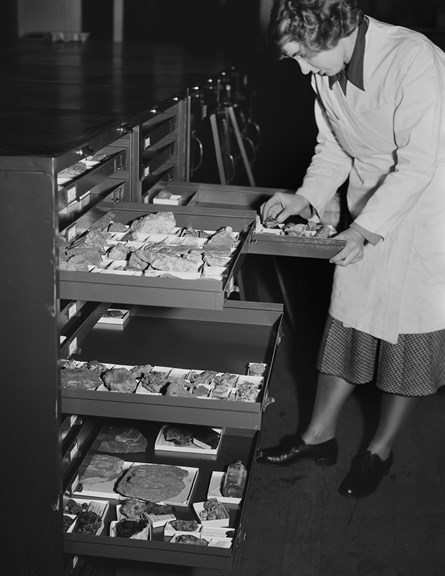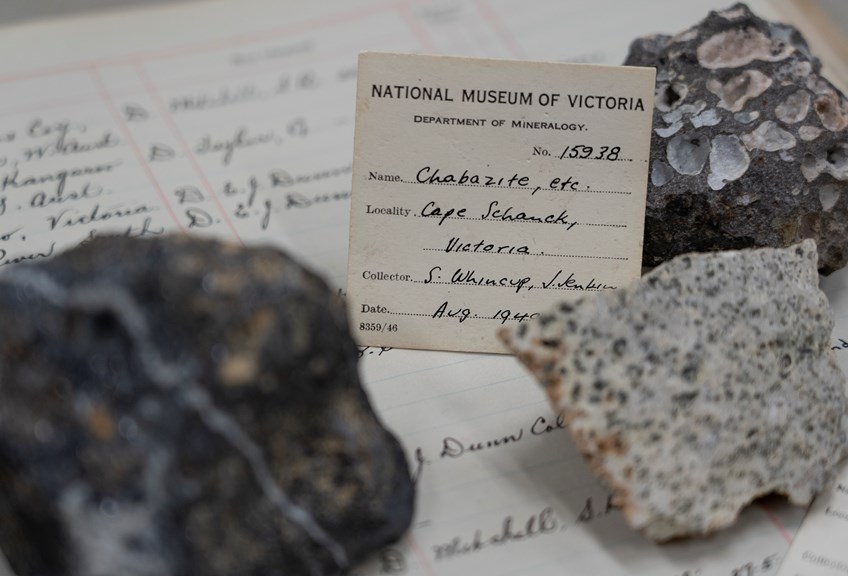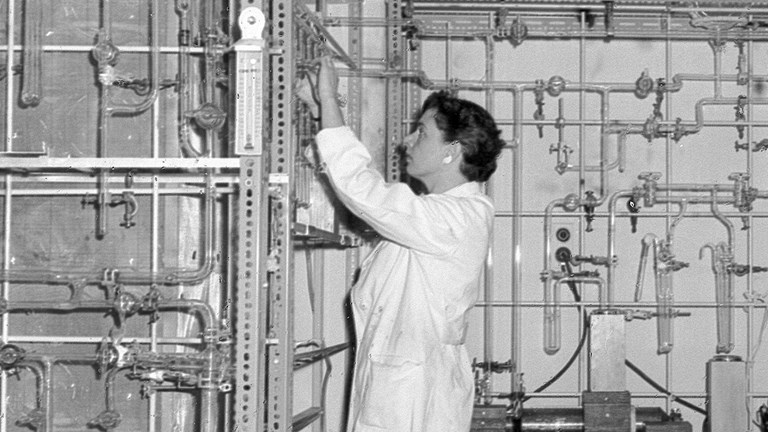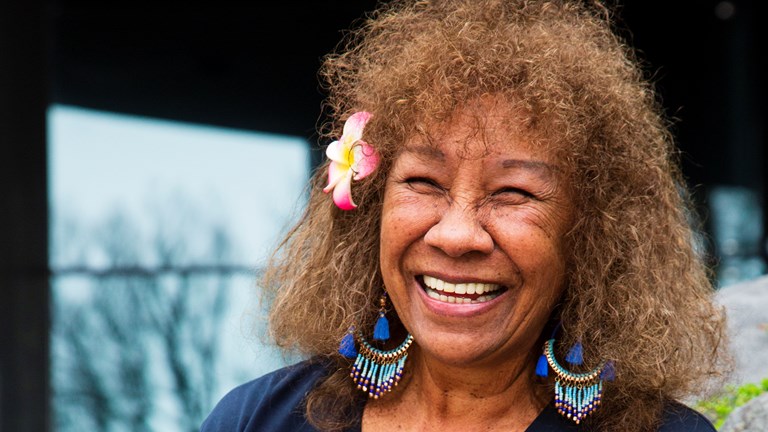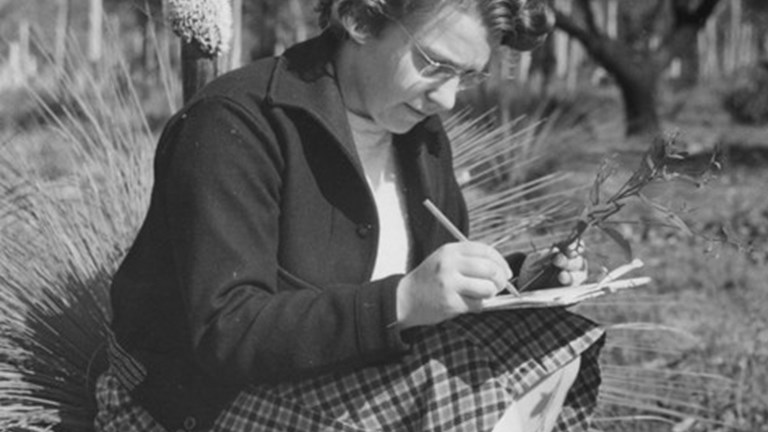Sylvia Whincup, a prolific collector and groundbreaking mineralogist
Sylvia Whincup’s career as a mineralogist at the museum lasted only four years, but in that time she amassed a collection of more than 5000 specimens and 167 new species.
Unearthing the stories of pioneering women from the Museums Victoria Archives.
Born in rural Victoria in 1921, Sylvia’s father explicitly discouraged her from tertiary education—but it didn’t stop her.
Sylvia excelled in her studies at the University of Melbourne, graduating with a masters in geology in 1943 and finding a husband in the process.
She married Reg Whincup, a flying officer with the Royal Australian Air Force, at the university’s Trinity College Chapel in April 1943.
Just a year later, though, Reg's plane was shot down over Indonesia in World War II and he was killed, while Sylvia was pregnant.
It was against this backdrop that Sylvia published her master thesis, on the genesis of sand dunes on Victoria’s Mornington Peninsula, in 1944.
The article would have been noted by staff at the museum before Sylvia was appointed as a mineralogist two years later.
‘In 1944 Mr RTM Pescott was appointed Museum Director, and it was largely through his efforts that Mrs Sylvia Whincup was appointed to the position of mineralogist in 1946. After she joined the staff the collections grew more rapidly, and a start was made to arrange the Mineral Reference Collection systematically.’AW Beasley, curator of minerology, 1970.
The Museum had been without a mineralogist or curator of minerals for more than 25 years before Sylvia’s arrival.
Staff numbers at the museum were depleted during the Great Depression in the 1930s, and it took much work from subsequent directors to build support with the government to fill positions long left vacant.
After her first year at the museum Sylvia reported, ‘The greater part of the time of this officer has been given to the reorganising and registration of the very large mineral and rock collection that has accumulated over a number of years, and which has not had satisfactory attention for many years’.
Her time wasn’t all spent on reorganisation though.
A prolific collector
‘Sylvia was the first member of museum staff to actively go out and collect mineral specimens,’ says the Museums Victoria’s current geosciences collection manager, Oskar Lindenmayer.
‘During her time as the mineralogist at the museum, the mineral diversity of the collection really increased quite a lot.’
Sylvia added more than 5000 specimens to the collection, including 167 new species—an increase of over 30 per cent in just four years.
‘It sets her time apart from the 100 years before and the 25 years after, in terms of the way the collection grew.’Oskar Lindenmayer
Oskar says Sylvia was also instrumental in setting up the first displays of the museum’s gem collection for the public.
‘She realised that was an important way people related to mineralogy,’ says Oskar.
It’s a feature that continues to this day in the Melbourne Museum’s Dynamic Earth exhibition.
Sylvia also participated in one of the first scientific studies of the Snowy River area, in north-eastern Victoria, with fellow museum staff Charles Brazenor, Charles Gabriel, Hope Macpherson and AN Burns.
Resignation
In 1950 though, Sylvia remarried and was forced to leave the museum.
At the time, married women were not allowed to join, or continue in, the public service due to the ‘marriage bar’—a rule that continued to be enforced until 1966.
‘It is with both pleasure and gratitude that I record my deep appreciation of the unfailing kindness, courtesy and cooperation tendered to me by yourself personally, and by every member of the staff,’ Sylvia wrote in her resignation to the museum’s director Richard Pescott.
Mr Pescott urgently appealed to the Public Service Board for an exemption, to keep Sylvia on staff for two months after her marriage.
‘Mrs Whincup has such a specialised knowledge, particularly of gemstones and their identification, that this museum will be placed in a most embarrassing position until a replacement is made.
‘The value of this department to the community will be seen from the fact that Mrs Whincup, over the past six months, has identified some 221 specimens for members of the general public in addition to a large collection of gemstones amounting to several hundred specimens,’ wrote Mr Pescott.
Sylvia moved to South Australia with her new husband—Bob Whitehead, a fellow geologist—where she raised three children.
She worked as a petrologist, mineralogist and economic geologist in private industry, including at BHP and Australian Mineral Development Laboratories, until her retirement in 1981.
Although Sylvia’s career at the museum was cut short, her legacy remains in the specimens she acquired—including the highly significant EJ Dunn collection—and her important curatorial work.
Museums Victoria now boasts the most mineral diverse collection in Australia, with more than 2770 species—in part due to Sylvia’s early development of the museum’s collection.

